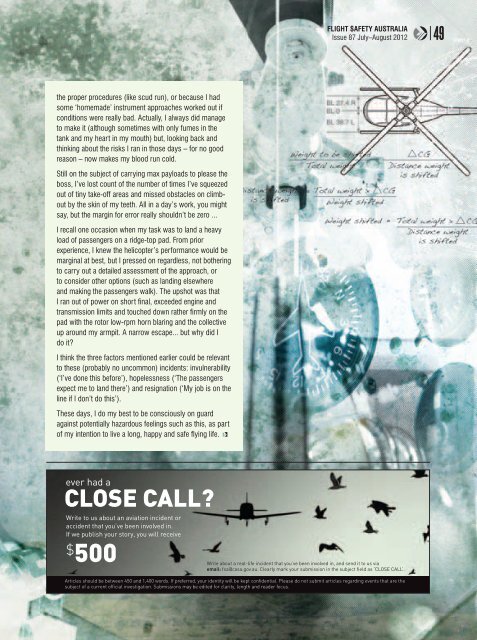jul-aug2012
Create successful ePaper yourself
Turn your PDF publications into a flip-book with our unique Google optimized e-Paper software.
Flight Safety Australia<br />
Issue 87 July–August 2012<br />
49<br />
the proper procedures (like scud run), or because I had<br />
some ‘homemade’ instrument approaches worked out if<br />
conditions were really bad. Actually, I always did manage<br />
to make it (although sometimes with only fumes in the<br />
tank and my heart in my mouth) but, looking back and<br />
thinking about the risks I ran in those days – for no good<br />
reason – now makes my blood run cold.<br />
Still on the subject of carrying max payloads to please the<br />
boss, I’ve lost count of the number of times I’ve squeezed<br />
out of tiny take-off areas and missed obstacles on climbout<br />
by the skin of my teeth. All in a day’s work, you might<br />
say, but the margin for error really shouldn’t be zero ...<br />
I recall one occasion when my task was to land a heavy<br />
load of passengers on a ridge-top pad. From prior<br />
experience, I knew the helicopter’s performance would be<br />
marginal at best, but I pressed on regardless, not bothering<br />
to carry out a detailed assessment of the approach, or<br />
to consider other options (such as landing elsewhere<br />
and making the passengers walk). The upshot was that<br />
I ran out of power on short final, exceeded engine and<br />
transmission limits and touched down rather firmly on the<br />
pad with the rotor low-rpm horn blaring and the collective<br />
up around my armpit. A narrow escape... but why did I<br />
do it?<br />
I think the three factors mentioned earlier could be relevant<br />
to these (probably no uncommon) incidents: invulnerability<br />
(‘I’ve done this before’), hopelessness (‘The passengers<br />
expect me to land there’) and resignation (‘My job is on the<br />
line if I don’t do this’).<br />
These days, I do my best to be consciously on guard<br />
against potentially hazardous feelings such as this, as part<br />
of my intention to live a long, happy and safe flying life.<br />
ever had a<br />
CLOSE CALL?<br />
Write to us about an aviation incident or<br />
accident that you’ve been involved in.<br />
If we publish your story, you will receive<br />
$<br />
500<br />
Write about a real-life incident that you’ve been involved in, and send it to us via<br />
email: fsa@casa.gov.au. Clearly mark your submission in the subject field as ‘CLOSE CALL’.<br />
Articles should be between 450 and 1,400 words. If preferred, your identity will be kept confidential. Please do not submit articles regarding events that are the<br />
subject of a current official investigation. Submissions may be edited for clarity, length and reader focus.

















